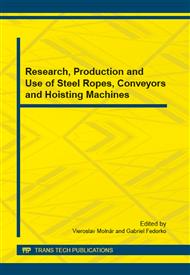p.73
p.78
p.86
p.92
p.97
p.102
p.108
p.114
p.119
Application the Renewal Theory to Determining the Models of the Optimal Lifetime for Conveyor Belts
Abstract:
Belt conveyance belongs to the continual transport systems characteristic with high-level conveying performances. Belt conveyors are of significant importance in the transportation of various types of materials in the industries like engineering, metallurgy and construction. The fundamental and the most expensive component of belt conveyors is the conveyor belt which is, during the operation on the belt conveyor, exposed to number of various loads that evoke the process of conveyor belt wear and damage. Lifetime of conveyor belts, which is the determining parameter for the belt conveyance economy and efficiency, is very important for the practice.Issues regarding the conveyor belt lifetime should be solved applying also the methods of operation analysis, especially the linear programming and the renewal theory that uses the theory of probability and mathematic statistics. The objective of our research was to determine the optimal lifetime (optimal performance duration) of a belt conveyor, applying the renewal theory, whereas the research was based on the cost approach of the renewal process.
Info:
Periodical:
Pages:
97-101
Citation:
Online since:
October 2014
Authors:
Price:
Сopyright:
© 2014 Trans Tech Publications Ltd. All Rights Reserved
Share:
Citation:


